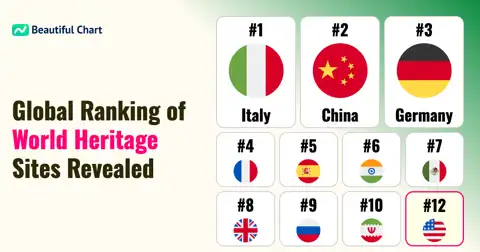This chart ranks countries by their gold reserves in 2024. The United States leads with over 8,100 tonnes, followed by Germany with more than 3,300 tonnes. Italy, France, and Russia complete the top five, with reserves ranging between 2,300 and 2,450 tonnes. China holds the sixth position, while Japan and India are among the top 10. Notably, Australia and Indonesia rank much lower, at 40th and 42nd respectively.
Gold reserves refer to the quantity of gold held by a nation's central bank or treasury. These reserves are used as a store of value and a form of financial security, often to back a country's currency or support its economy in times of crisis. Gold reserves are typically measured in metric tonnes.
In 2024, global gold reserves continue to be dominated by the world's leading economies, reflecting the importance of gold as a strategic asset for national wealth and stability. The United States, with over 8,133 tonnes of gold, far outpaces other nations, maintaining its longstanding position as the largest holder of gold reserves. Germany, despite having less than half the gold reserves of the United States, holds the second-largest stockpile with 3,352 tonnes, followed closely by Italy, France, and Russia, whose reserves all hover around 2,400 tonnes.
Interestingly, Russia and China, with significant geopolitical and economic influence, maintain substantial gold holdings. China's 2,264 tonnes, ranked sixth, reflect its ongoing efforts to diversify its reserves away from foreign currencies like the US dollar. Russia's reserves, slightly higher at 2,336 tonnes, have likely been a strategic move to strengthen the ruble and reduce dependency on Western financial systems, especially in light of ongoing geopolitical tensions.
Other major economies, including Switzerland, Japan, and India, maintain significant but smaller reserves, each with less than 1,100 tonnes. Notably, Japan and India, ranked 8th and 9th respectively, each hold under 850 tonnes, a reflection of their more diversified reserve strategies, which include significant foreign exchange reserves and other assets.
The Netherlands rounds out the top 10, followed by Turkey, whose relatively large reserves of 585 tonnes place it in 11th position. Outside the top 10, the UK holds a surprisingly low 310 tonnes, ranking 17th, which contrasts with its historical significance as a major financial center.
Further down the list, countries like Australia and Indonesia hold far smaller reserves, with under 80 tonnes each, despite their large economies and significant roles in the global market. This suggests that these nations prioritize other forms of reserves and investments over gold. The distribution of gold reserves across countries indicates ongoing trends in economic stability, currency diversification, and geopolitical strategies, particularly among major powers like the US, China, and Russia.
| Rank | Name | Indicator |
|---|---|---|
1 | 8,133.0 tonnes | |
2 | 3,352.0 tonnes | |
3 | 2,452.0 tonnes | |
4 | 2,437.0 tonnes | |
5 | 2,336.0 tonnes | |
6 | 2,264.0 tonnes | |
7 | 1,040.0 tonnes | |
8 | 846.0 tonnes | |
9 | 841.0 tonnes | |
10 | 612.0 tonnes | |
11 | 585.0 tonnes | |
12 | 422.0 tonnes | |
13 | 383.0 tonnes | |
14 | 377.0 tonnes | |
15 | 365.0 tonnes | |
16 | 323.0 tonnes | |
17 | 310.0 tonnes | |
18 | 299.0 tonnes | |
19 | 287.0 tonnes | |
20 | 282.0 tonnes |





